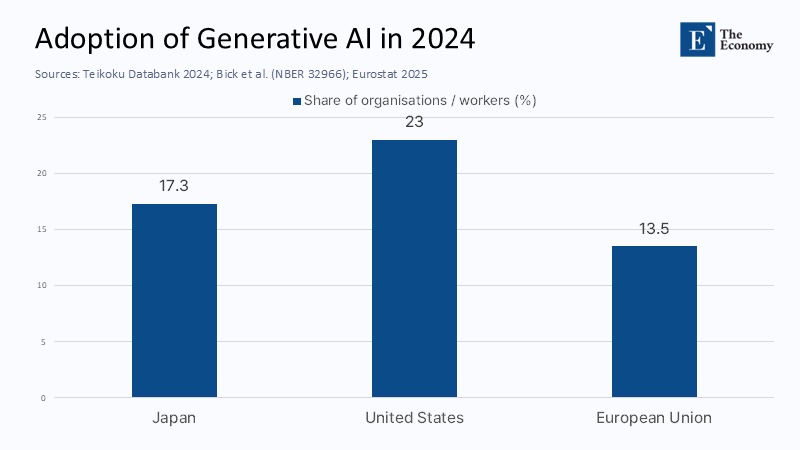Input
Changed
This article was independently developed by The Economy editorial team and draws on original analysis published by East Asia Forum. The content has been substantially rewritten, expanded, and reframed for broader context and relevance. All views expressed are solely those of the author and do not represent the official position of East Asia Forum or its contributors.
The most expensive delusion in technology policy today is the belief that a large-language model is a fetal consciousness that must be caged. Strip away the marketing gloss, and every system from ChatGPT to Japan's own Sakana-LM still functions as what the late linguist Emily Bender calls "a stochastic parrot": a statistical engine that guesses the next token in a sequence. Treat that parrot as a prophet, and lawmakers reach reflexively for handcuffs; recognize it as a pattern-recognizer, and you instead go for leverage. And let’s be blunt: nobody with a deadline trusts ChatGPT’s answers un-checked; it is Google on steroids—brilliant some days, dead wrong others. In February 2025, Tokyo embraced the second path, rolling out the world's most advanced and permissive governance framework for generative AI while approving a ten-trillion-yen industrial stimulus. This column unpacks why the move is more than regulatory minimalism, how early metrics suggest it expands adoption, and what lessons education leaders should draw before their legislatures lock the door on innovation. It emphasizes the global implications of Japan's approach while stripping away the ethical stagecraft some commentators perform to sound enlightened.

Statistical Engines, Not Ethereal Minds
Technical reality first. Peer-reviewed studies that measure "hallucination" across 30 languages show that even state-of-the-art models generate factually spurious tokens in roughly 7 – 12% of answers, with smaller models and longer responses doing worse. Other benchmarking on specialized medical and legal questions still reports error bands in the mid-teens. Those numbers are embarrassing if the system is consulted as an oracle, but perfectly acceptable if it is deployed as a co-pilot whose output is constantly vetted by a human. The Japanese Cabinet Office's Interim Report on AI Policy enshrines precisely that framing, defining generative models as "probabilistic software" subject to pre-existing laws on data protection, product safety, and defamation, not as sui generis intelligences that require a new ministry. By refusing to inflate metaphysics into statute, Tokyo frees managerial bandwidth to solve the only question that matters for a shrinking, aging society: how fast can these parrots be re-trained to shoulder clerical drudgery at scale?
Tokyo's Regulatory Pivot: The Architecture of Light Touch
The February package established an AI Incident Analysis Secretariat inside the Cabinet Office with no licensing authority, mandated quarterly guidance updates by the Ministry of Economy, Trade and Industry (METI), and instructed every line ministry to map AI risks onto statutes it already enforces. The resulting compliance journey for a start-up is startlingly short: build, self-assess against the 34-page METI AI Guidelines for Business, register with the existing data-protection commission if you handle personal information, and launch. Sector regulators intervene ex-post if harms cross a threshold, mirroring how Japan already polices pharmaceuticals or consumer electronics. Contrast that economy of design with Brussels' AI Act, which introduces new conformity-assessment tiers and fines up to 7% of global turnover; early industry modeling estimates that merely setting up the mandated Quality-Management System will cost an SME between €193,000 and €330,000 upfront plus €71,400 every year after. Where Brussels codifies caution, Tokyo codifies optionality.
Evidence on the Ground: Adoption, Perception, Momentum
That difference is shown in first-year adoption data. A Teikoku Databank survey of 4,705 Japanese firms in August 2024 found that 17.3% had already embedded generative AI in live workflows, a figure only six points behind the United States (23 % of workers, according to an NBER national panel) and nearly four points ahead of the European Union's 13.5% enterprise average reported by Eurostat.

Perception moves in tandem. A Nomura Research Institute poll of 8,900 employees shows 41.8% of respondents feel "positive" about generative AI—nearly double the 22.8% who fear job loss. Cultural anxiety is lower precisely because the state has not narrated the technology as looming doom.
Follow the Money: Industrial Policy with Teeth
A light touch does not mean a light wallet. In November 2024, Prime Minister Shigeru Ishiba unveiled a ten-trillion-yen (≈ US $65 billion) subsidy plan for semiconductors and AI, with ¥1.5 trillion booked in the supplementary budget and the balance to be mobilized by 2030. By headline value, the package eclipses the US$52.7 billion appropriated by the USUS CHIPS and Science Act and the €43 billion public pillar of the EU Chips Act.

Funding has already been converted into steel and silicon. Rapidus—the public-private venture building a 2-nanometre fab in Hokkaido—has secured ¥330 billion in direct grants and opened a pilot line in April 2025; negotiations with Apple, Google, and Meta for volume contracts are underway, backed by a fresh ¥200 billion tranche for fiscal 2025. Locating bleeding-edge capacity inside Japan collapses the feedback loop between model demand and chip supply, cutting freight time for developers and lowering strategic dependence on Taiwan.
The Demographic Deadline: Why Japan Cannot Afford Delay
All of this is propelled by relentless demography. By 2030, the share of citizens over 65 will crest 31%, leaving fewer than two workers for every retiree. Without automation, healthcare, logistics, and public finance math does not add up. Robots that draft discharge summaries, large-language agents that translate nursing instructions into Vietnamese for foreign care workers, and predictive-maintenance models that keep aging factory equipment running are not optional—they are fiscal stabilizers. In the master-and-servant calculus, every hour the parrot saves is an hour the human master can invest in care, design, or teaching.
Comparative Costs: When Compliance Becomes a Barrier to Innovation
The opportunity cost of caution is global. McKinsey's March 2025 State of AI survey finds that more than three-quarters of companies now use some form of AI. Still, organizations in high-regulation jurisdictions lag their peers by double-digit percentages in new generative AI pilots. CEPS modeling suggests that for a European SME, the direct cash burn of AI-Act compliance rivals 40% of the annual profit. Not surprisingly, anecdotal reports show European founders shifting early research to the United States or Asia to escape uncertainty. Japan's design dodges that brain-drain trap while preserving the option to legislate narrowly if empirical harms spike. Europe preaches ethics, Tokyo practices efficiency.
Classrooms as Amplifiers: Building a Workforce of Prompt Engineers
Policy coherence runs through education. The Ministry of Education's 2024 curriculum revision requires every upper-secondary student to demonstrate AI literacy before graduation, embedding Python exercises in history as readily as in computer science. METI guidelines encourage universities to fine-tune open-weight Japanese models on non-sensitive corpora, turning campuses into living labs rather than legal minefields. The effect is compounding: each cohort enters the labor market already fluent in prompting, evaluation, and risk awareness, accelerating diffusion across SMEs that cannot afford in-house data scientists.
Strategic Spill-Overs: Chips, Alliances, and an Unfolding Geopolitical Play
Japan's bet has externalities beyond GDP. As USUS–China tech rivalry intensifies, global manufacturers want a third site for advanced node production. With Rapidus courting USUS cloud giants and TSMC constructing its own Kumamoto fab, the archipelago is fast becoming a geostrategic redundancy zone for leading-edge silicon. Meanwhile, the light-touch model signals to ASEAN partners that Tokyo is open for regulatory alignment, making it easier for Indonesian or Vietnamese start-ups to plug Japanese-language models into regional platforms without re-licensing hoops. Soft power, here, is expressed in default API endpoints rather than treaties.
Implications for Educators and Policymakers Beyond Japan
What lessons travel? First, the policy should be calibrated to statistical fact, not science fiction. Second, map novel risks to extant laws before creating a fresh layer of bureaucracy. Third, price the adoption lag: a single lost year in curriculum reform today becomes a decade of wage stagnation tomorrow. Japan's framework is not laissez-faire; it is conditional trust, hedged with sectoral back-stops and massive public investment. For university administrators, the takeaway is licensure to experiment now—open-weight models, local corpora, multilingual testing—without waiting for Brussels-style conformity assessments. For lawmakers, the caution is symmetrical: every extra page of the statute should be weighed against real-option value in a technology field still doubling its annual parameter count.
Mastery, Not Mystery
Treating AI as a servant rather than a specter re-aligns economic priorities around productivity, education, and strategic depth. Japan has executed that pivot first among advanced democracies, and early indicators—from adoption surveys to subsidy flows—suggest the payoff could be swift. If the parrot lightens clerical loads, powers bilingual classrooms, and prints 2-nanometre chips onshore, Tokyo's light-touch regime will have outperformed precautionary competitors long before any theoretical existential risk materializes. The rest of the world would do well to listen to the bird before it slams its cage shut because it treats algorithms as obedient staff, not sentient colleagues
The original article was authored by Sun Ryung Park, a Senior Research Scholar at the Asia Pacific Foundation of Canada. The English version, titled "Less regulation, more innovation in Japan's AI governance," was published by East Asia Forum.





















